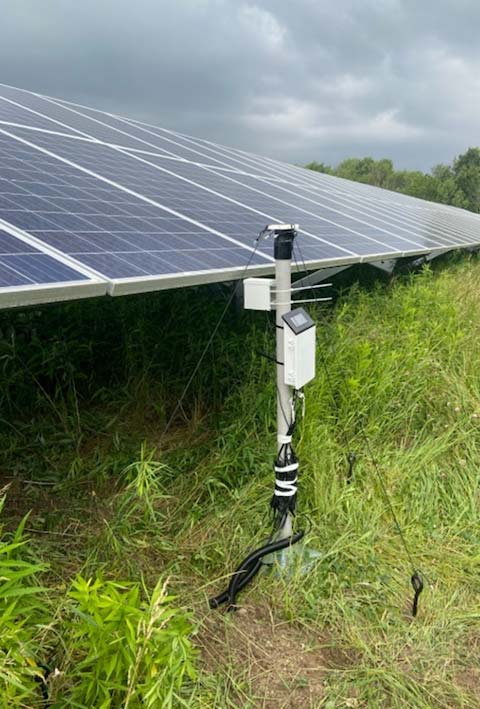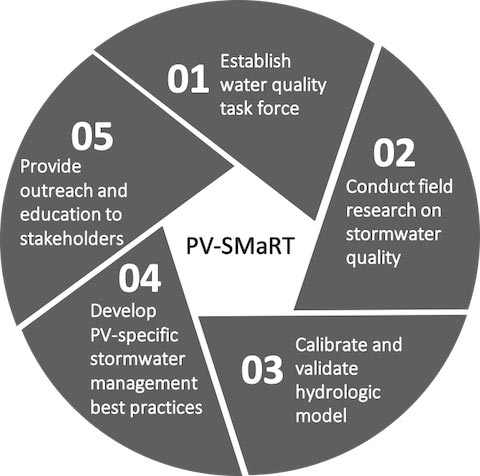Photovoltaic Stormwater Management Research and Testing

PV-SMaRT field-testing equipment monitoring underground soil moisture at a New York PV facility. Photo from Scott McArt, Cornell University

The Photovoltaic Stormwater Management Research and Testing (PV-SMaRT) project is developing and disseminating research-based, PV-specific tools and best practices for stormwater management and water quality at ground-mounted PV sites.
To achieve PV-SMaRT's goal, NLR is partnering with the University of Minnesota, Great Plains Institute, and Fresh Energy.
Stormwater Management for PV Facilities
Many jurisdictions treat ground-mounted PV facilities as predominantly impervious surfaces or surfaces that do not allow water to soak into the ground. However, rather than acting like a paved surface, rainwater can generally infiltrate under elevated PV arrays.
Because current stormwater runoff models used by local and state jurisdictions were not designed for ground-mounted PV, the stormwater permitting process can impose costly additional stormwater infrastructure requirements. Often, additional land must be leased or purchased for stormwater mitigation measures, such as detention ponds. The permitting process also often lacks accuracy and leaves unanswered questions for jurisdictions when they attempt to evaluate applications for risks and opportunities associated with ground-mounted PV facilities.
Through its research and analysis, the PV-SMaRT project aims to address the stormwater and water quality challenges facing PV facilities in most jurisdictions.
Research Findings
PV-SMaRT's research and modeling highlight four factors that should be considered in stormwater management and water quality permitting for PV arrays (in order of greatest impact):
Compaction—managing soil compaction and bulk density across the site
Soil depth—including soil depth (rooting depth) in stormwater modeling and design
Ground cover—installing, establishing, and maintaining appropriate vegetated ground cover between and under the arrays to facilitate infiltration
Disconnection—ensuring appropriate distance between arrays for infiltration.
These factors are drawn from the report Best Practices: Photovoltaic Stormwater Management Research and Testing (PV-SMaRT), published by the Great Plains Institute, a PV-SMaRT partner.
Stormwater Runoff Calculator
PV-SMaRT has developed an easy-to-use calculator to estimate stormwater runoff from ground-mounted PV arrays. This calculator is based on research and hydrologic modeling conducted at a set of research sites featuring diverse climatic, topographic, and soil conditions, with either fixed or tracking solar arrays, and vegetation that included pollinators, grass, or cover crops.
Climatic and hydrologic field measurements at each site were used to develop a two-dimensional numerical model for stormwater runoff based on specific combinations of a wide range in 24-hour design storms, soil textures, crop rooting depth, soil bulk densities, presence or absence of solar arrays, spacing of solar arrays, type of ground cover, and slope steepness values.
To learn how to use the calculator, watch this recording of a webinar hosted by Fresh Energy.
PV Field Research Sites
The PV-SMaRT project is using five ground-mounted PV sites in the United States to study stormwater infiltration and runoff. These sites represent a range of elevations, slopes, soil types, and geographical locations. The unique conditions at each site are being characterized, and measurements are being taken of soil infiltration, runoff, site vegetation density, speciation and rooting depth, precipitation, and drip edge runoff.
Minnesota
Minnesota's site has a 3.4-megawatt (MW) DC, fixed-mount, two-in-portrait PV array. It has sandy soil with a pollinator mix dominated by black-eyed Susan daisies and receives 37 in. of annual rainfall. Equipment was installed in June 2020 and will operate for 2 years.
New York
New York's site has an 18-MW DC, fixed-mount, two-in-portrait PV array. It has silt loam soil with a tall grass and clover mix, is ungrazed or grazed by sheep, and receives 49 in. of annual rainfall. Equipment was installed in June 2020 and will operate for 2 years.
Oregon
Oregon's site has a 9.9-MW DC, tracking, two-in-portrait PV array. It's a flat site with clay soil, a diverse pollinator seed mix, and 16 in. of annual rainfall. Equipment was installed in August 2020 and will operate for 2 years.
Colorado
Colorado's site has a 1-MW DC, tracking, one-in-portrait PV array. It has clay soil and pollinator-friendly vegetation and receives 16 in. of annual rainfall. Equipment was installed in September 2020 and will operate for 2 years.
Georgia
Georgia's site has a 1.3-MW DC, tracking, one-in-portrait PV array. It's a flat site with sandy clay soil, mowed cover crops, a high-diversity pollinator mix, and 49 in. of annual rainfall. Equipment was installed in September 2020 and will operate for 2 years.
Water Quality Task Force
The PV-SMaRT water quality task force works closely with the project team to provide feedback and guidance on the technical analysis, modeling, validation, and creation of water quality best practices. The task force is made up of individuals who represent a variety of views and stakeholder groups, including water quality experts, stormwater professionals, and solar industry representatives. Task force members understand the landscape of technical, strategic, permitting, and ground-mounted PV site development issues to meeting water quality goals.
Task force members include:
- Jason Bernagros, U.S. Environmental Protection Agency (EPA) Office of Research and Development
- Seth Brown, National Municipal Stormwater Association
- Veronica Craw, Georgia Department of Natural Resources
- Dave Gasper, New York Department of Environmental Conservation
- Robert Goo, EPA Office of Wetlands, Watersheds
- Britta Hansen, Emmons Olivier Resources
- Greg Hoffman, Center for Watershed Protection
- Jake Janski, Minnesota Native Landscapes
- Gavin Chase Meinschein, Engie North America
- David Morley, American Planning Association
- Andrew Nelson, Westwood Professional Services
- Peter Parkinson, AES Distributed Energy
- Sybil Sharvelle, Colorado State InTERFEWS Director.
Publications
Measuring and Modeling Soil Moisture and Runoff at Solar Farms Using a Disconnected Impervious Surface Approach, Vadose Zone Journal (2024)
Best Practices: Photovoltaic Stormwater Management Research and Testing (PV-SMaRT), Great Plains Institute Report (2023)
Creating Water Quality Value in Ground-Mounted Solar Photovoltaic Sites, International Erosion Control Association News Story (2022)
PV-SMaRT: Potential Stormwater Barriers and Opportunities, Great Plains Institute (2021)
InSPIRE: Innovative Solar Practices Integrated With Rural Economies and Ecosystems Website, OpenEI
Contact
Share
Last Updated Dec. 5, 2025
